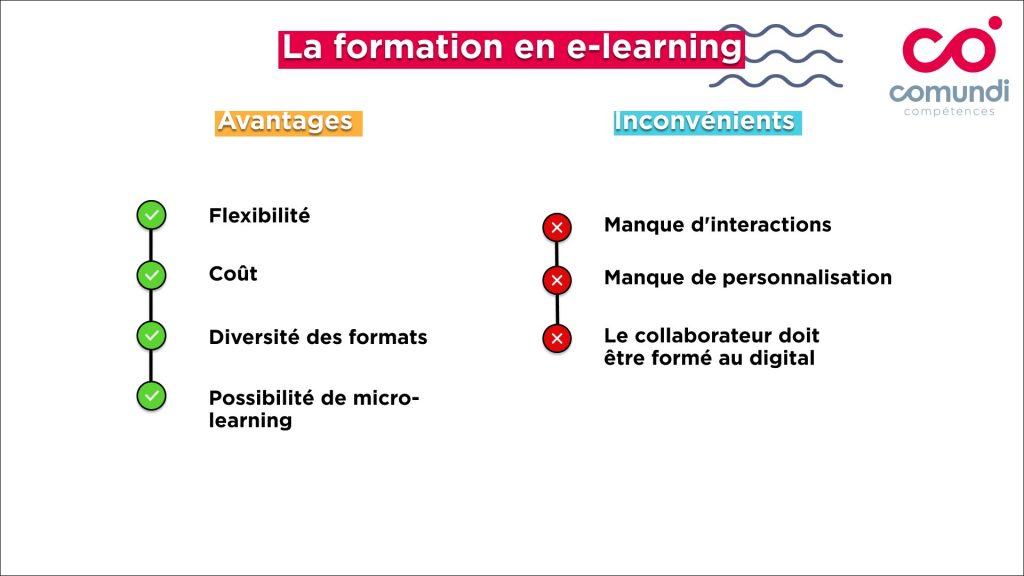The pros and cons of e-learning: a comprehensive analysis
In this article, we'll take a closer look at the different facets of e-learning. The undeniable advantages of this method of education include flexibility, accessibility and personalization. However, it's important to note the potential drawbacks too, such as the lack of social interaction and the need for increased self-discipline. In conclusion, e-learning is a powerful tool that offers many benefits, but also requires reflection on its limitations.
The e-Learning Advantage
[arve url="https://www.youtube.com/embed/nzV1NmhC7ik "/]
What are the disadvantages of e-learning?
E-learning has certain drawbacks that can limit its effectiveness and accessibility.
First and foremost, dependence on technology can be a major obstacle. If learners don't have access to a reliable Internet connection or adequate computer equipment, they won't be able to take full advantage of e-learning. This can create digital exclusion, particularly for people living in rural or disadvantaged areas.
What's more, lack of direct human interaction can be seen as a disadvantage. Online learning is often done on an individual, isolated basis, which can be less stimulating and motivating than direct contact with a teacher or other learners in the classroom. Social support and the exchange of ideas can also be limited.
In addition, discipline and self-motivation are essential for success in e-learning. Without the setting of a traditional classroom, some learners may find it difficult to stay motivated and meet deadlines. This increases the risk of procrastination.
Finally, the difficulty of controlling teaching quality can be a drawback. With the proliferation of online platforms and user-generated content, it can be difficult for learners to distinguish reliable sources and ensure they are receiving quality instruction.
It is important to take these disadvantages into account when setting up e-learning programs, in order to find appropriate solutions to mitigate them and maximize the benefits of this learning modality.
What are the disadvantages of e-learning?
One of the disadvantages of e-learning is the lack of direct human interaction. Unlike a traditional classroom, where students and teacher can interact face-to-face, online learning takes place mainly via virtual platforms. This can lead to a certain distance and a lack of personal involvement.
Another disadvantage is the potential lack of motivation. Since online learning generally relies on self-discipline and self-organization, it can be more difficult for some students to stay motivated and attend classes regularly. Without the group effect and social pressure of a physical classroom, it can be more tempting to procrastinate or miss class sessions.
In addition, lack of access to suitable equipment and a stable Internet connection can be a barrier to e-learning. Not everyone has the same resources and infrastructure to participate effectively in online courses. This can create inequality of access and prevent some individuals from benefiting fully from e-learning.
What's more, e-learning can be less interactive and hands-on than face-to-face learning. Online discussions may be more limited and less spontaneous than face-to-face interactions. Access to specific equipment or hands-on labs may also be restricted.
Finally, it should be noted that some subjects may be more difficult to teach and learn online. For example, courses requiring physical interaction or hands-on demonstrations may be less effective in an e-learning environment. Similarly, learning foreign languages or correct pronunciation may be more complicated without the direct assistance of a teacher.
It's important to take these drawbacks into account when setting up an e-learning program to maximize efficiency and the student experience.
What are the disadvantages of professional training?
The disadvantages of vocational training
Professional training is an indispensable tool for acquiring new skills and retraining. However, it also has a number of disadvantages that need to be taken into account.
1. High cost : Vocational training can represent a significant financial investment, especially for individuals who have to finance their training themselves. Some training programs can be costly, requiring careful financial planning.
2. Time required : Vocational training requires an investment of time. People who take courses often have to cope with constraints linked to their professional and personal responsibilities. Reconciling training and work can be complex, and requires rigorous organization.
3. Content adaptability : The content of some vocational training courses may not be entirely tailored to the specific needs of an individual or a company. Programs may be too generic or fail to take account of rapid changes in the job market, limiting the relevance of the skills acquired.
4. Lack of recognition : In some cases, vocational training may not be sufficiently valued by employers or the job market in general. Some courses may appear less prestigious than other types of university degree, which can affect career opportunities.
5. Skills obsolescence : In an ever-changing world, some of the skills acquired through vocational training can quickly become obsolete. It is therefore important to continue training throughout one's career in order to remain competitive on the job market.
In conclusion, although vocational training has certain disadvantages, it remains a crucial step in developing skills and accessing new professional opportunities. Weighing up the pros and cons is essential to making an informed decision about training investment.
In conclusion, e-learning has both advantages and disadvantages. On the one hand, it offers temporal and geographical flexibility, enabling learners to follow courses at their own pace, wherever they are. What's more, it provides access to a vast amount of online learning content and resources. This gives a variety of choices for learning and facilitates the personalization of the learning experience.
On the other hand, e-learning can be a source of loneliness and lack of social interaction, which can be detrimental to some learners who need a group environment to learn effectively. In addition, it requires a certain discipline and motivation on the part of learners to stay engaged and complete courses. Finally, some areas of knowledge require direct interaction with a teacher or hands-on experience that cannot be replicated online.
All in all, e-learning is an attractive option for those seeking to learn at their own pace and according to their own needs, while having access to a large quantity of teaching resources. However, it's important to consider the potential drawbacks, such as the lack of social interaction and self-discipline required. It is therefore crucial to carefully assess one's own preferences and learning needs before deciding to opt for e-learning.








